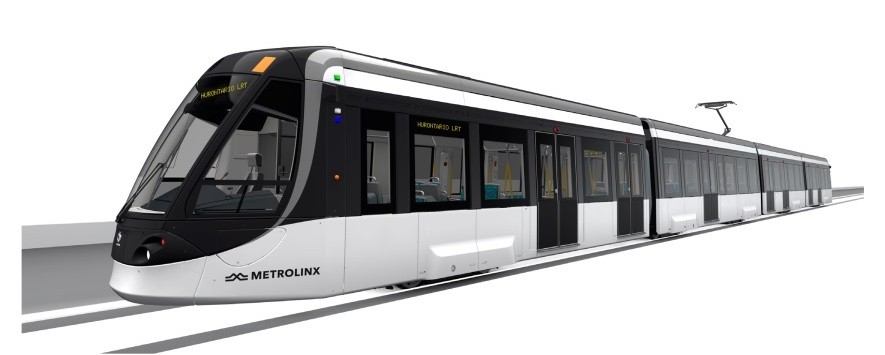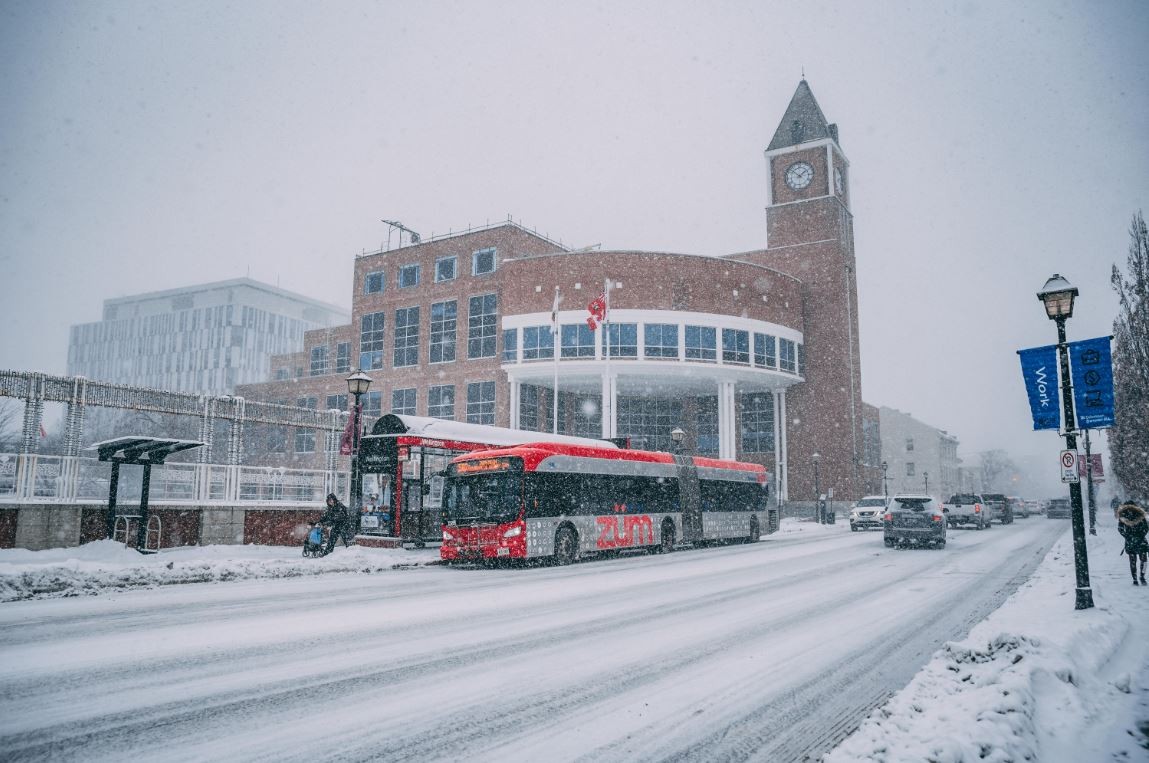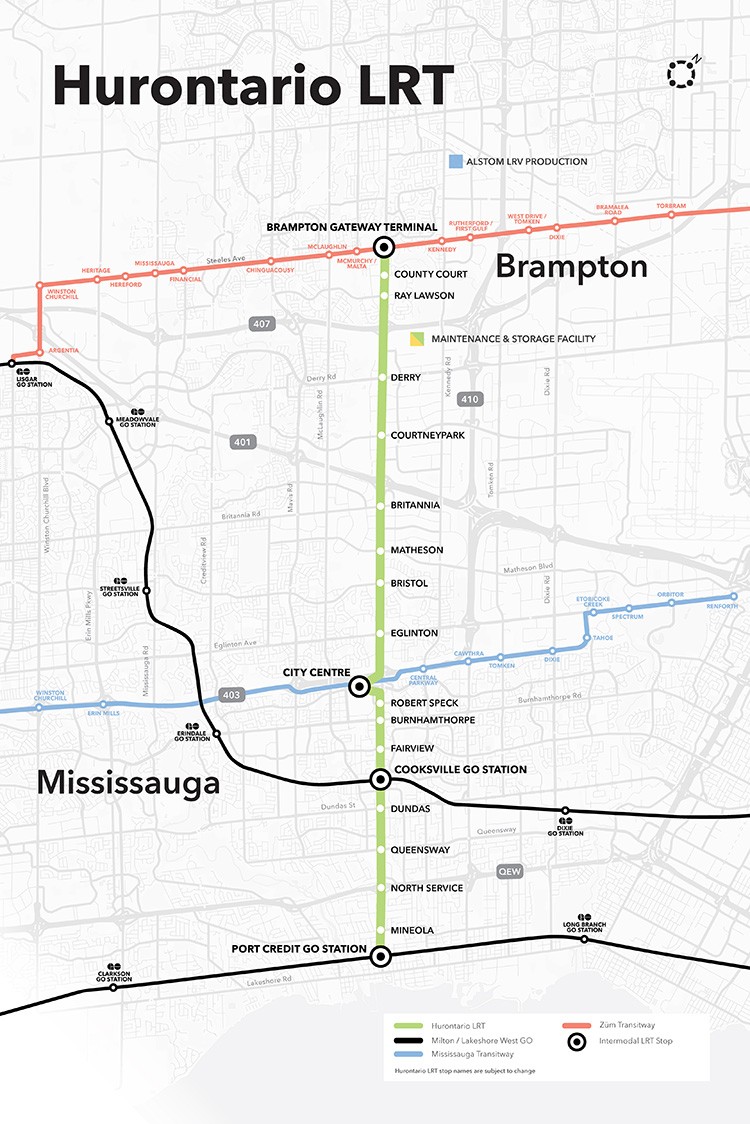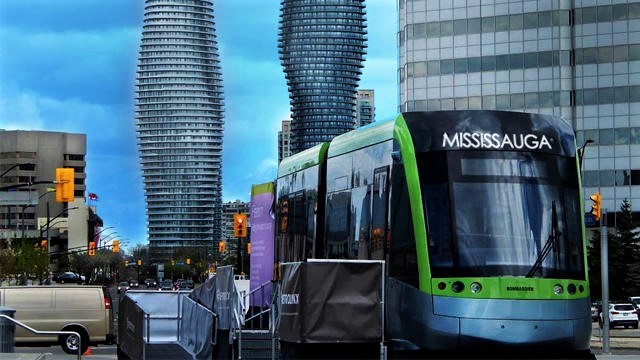
In 2018 Metrolinx quietly cut Hurontario LRT capacity, increasing peak wait times by 50%
Standing on the edge of Hurontario Street, sipping an espresso and watching the world flow past can be relaxing in the summer. Even beside a bustling thoroughfare, waiting for transit in perfect conditions has the potential to be enjoyable.
In the winter, it’s not.
When even your teeth hurt from the cold, it’s nightmarish.
In Canada’s sub-zero winter months, waiting for transit is anything but a pleasant experience, even with a perfect cup of espresso in hand. Those with cars, who might be tempted to ride a bus in the summer — perhaps to justify an after-work drink — will often eschew transit during the winter.

Waiting for a bus in these conditions is not a pleasant experience.
The regularity and frequency of public transportation is even more important during the coldest season. No one wants to arrive at their icy bus stop only to find the just-departed ride was a couple minutes ahead of schedule. Being stuck in the slush for even ten minutes is enough to lose another transit rider.
Effective subway networks operate on the philosophy that convenience is the key to system-wide success. But that principle — at the heart of all good transit planning — appears to have been forgotten by those delivering the Hurontario LRT.
The project, central to so much of Mississauga’s future growth, is in the early stages of construction. It is due to begin service in September 2024, two years after it was originally scheduled to launch.
Since the game-changing light rail system was first announced, it has seen its scope cut again and again.
First, in 2015, Brampton City Council voted to reject the provincially funded project. The move meant the route was cut short by 3.6 kilometres and planned to terminate at Shoppers World Gateway Terminal instead of the downtown Brampton GO station.
Then, in March 2019, it was publicly announced Metrolinx would be removing the Mississauga downtown loop from the project, cutting another 2 kilometres. The move was protested vehemently by Mississauga Mayor Bonnie Crombie and her council colleagues in the run-up to the 2019 federal election, but has barely been mentioned since.
“We knew that the original budget that was proposed would never be sufficient to cover the cost of construction in 2020 to include the loop, as it was using 2009 dollars,” Crombie told The Pointer at the time. “We will continue working with the Province and the Federal government on potential funding opportunities in the future."
Additional cuts that were made in December, 2018 (before the public announcement about the loop’s removal) have now been revealed in a report by Ontario’s Auditor General. A decision was quietly made to significantly reduce the number of light rail vehicles set to run along Hurontario Street, resulting in much longer wait times and a less regular schedule which jeopardizes the potential success of the route.
In 2018, the number of vehicles set to run along the route dropped from 43 to 28, marking a serious impact on service delivery and dramatically reducing the convenience of a $1.4 billion higher order transit investment trumpeted as Mississauga’s arrival on the urban transit scene.
The selling point was supposed to be the convenience of an internal rail system as a much more appealing alternative to buses, and even cars.
The move came in tandem with the reduced length of the route, but far exceeded it in scope. Where the length was cut by 10 percent, the number of vehicles fell by 35 percent.

Current route for the Hurontario LRT.
As a direct result, wait times between light rail vehicles at peak time will increase 50 percent. Potential riders for the new LRT would previously have waited five minutes between trains during peak times — they now face an unappealing seven-and-a-half minute wait, which in biting winter weather could turn off many users.
“After issuing the Request for Proposal for the project in August 2017, Metrolinx received feedback from proponents that the cost of the project would be higher,” the Auditor General’s report explains. “In December 2018, the Ministry sought Treasury Board approval to reduce the scope of the project… The Treasury Board approved the reduced scope and reduced the line to the current 18 kilometres with 19 stops.”
The move, designed to save money, could throw planning off course. Ridership projections and assumptions compiled for Metrolinx in 2016 by consultancy group Steer Davies Gleave (since renamed Steer) were based on five minutes between trains at peak times. The cuts reduce the infrastructure’s convenience and could threaten ridership as a result.
“The proposed HLRT is assumed to operate at a five minute headway during the weekday peak periods, a seven-and-a-half minute headway during the midday and Saturdays and at a 10 minute headway early morning and Sundays,” the Steer report states. Axing one third of its vehicles forced Metrolinx to apply the midday schedule to peak journeys. Convenience and regularity informs the popularity of a transit route, meaning some core assumptions in the Hurontario LRT’s planning could now be wrong.

The number of rail cars on the Hurontario LRT has been dramatically reduced
Frequency definitions set out by the National Association of City Transportation Officials (NACTO), which includes Toronto and Hamilton among its international members, would class the Hurontario LRT as a “moderate volume” route and not “high volume” with its reduced regularity.
Metrolinx provided a lengthy quote extolling the virtues of the light rail system, while avoiding the impact reduced schedules could have on Mississauga residents and the overall success of the major transit corridor.
“Along with other scope modifications, the decision to change the number of vehicles ordered was made to reduce project costs while still achieving the project goal of providing a fast, reliable and seamless customer experience between the new Hurontario LRT line, the GO Transit network, and the local transit systems,” Fannie Sunshine, a Metrolinx spokesperson, told The Pointer.
“The Hurontario LRT is [still] a rapid transit route,” she stressed, saying signal priority at traffic lights and a separate lane would increase travel speed, especially during rush hour. This does not address the issue of regularity and wait times, factors that also inform journey time.
“The Hurontario LRT will revolutionize transit for Mississauga once it’s completed, rapidly moving people across our city,” Crombie said. “It will be the quickest mode of transportation up the Hurontario corridor. I also know that once the line is up and running, there will be opportunities to increase service. I will continue strongly advocating to other levels of government to ensure Mississaugans have reliable and quick public transit.”
Even with the harsh cuts to the Hurontario LRT’s scope, the budget has ballooned. According to the Auditor General’s report, the cost estimates increased $600 million from the original budget even after length, regularity and vehicle purchases were all reduced.
The project’s original budget sat at $5 billion to build and operate the system, with $1.4 billion set aside for construction of the old 20-kilometre route. After reducing the length and making various other cuts, Metrolinx received two acceptable bids for the project in 2019.
Both came in above the budget of $5 billion, with the winning bid of $5.6 billion, 12 percent above what was initially set aside. The construction budget ballooned 26 percent to $1.76 billion - or 97.7 million per kilometre.
The Province has agreed to fund $4.1 billion of the project's costs, leaving Mississauga and Brampton with the remaining $1.53 billion tab.
Brampton Transit general manager, Alex Milojevic, told The Pointer that operations and maintenance would be municipal responsibilities, but that revenue and cost-sharing plans would “be part of future discussions between both cities”. Geoff Wright, commissioner of transportation and works for the City of Mississauga, provided a similar response, specifying the two cities would be in charge of “day-to-day oversight, fare enforcement, safety/security of passengers, customer service and marketing, but will be receiving fare box and non-fare box revenue from the service.”
It’s unclear how each city plans to pay for its share of costs, if revenues do not cover the required funding to meet each municipality’s obligation. Brampton will only have three stops including the turning point at Steeles Avenue and required infrastructure there to send trains back south.
All of the route’s cuts, delays and cost overruns came before shovels even entered the ground. Construction delays in delivering major transit projects after work has started are also common, meaning more slimming of the already significantly reduced project could still take place.
If further cuts are made and even less frequent service has to be planned, the number of riders who fancy waiting for a train on Hurontario Street in the winter may drop as well.
Email: [email protected]
Twitter: @isaaccallan
Tel: 647 561-4879
COVID-19 is impacting all Canadians. At a time when vital public information is needed by everyone, The Pointer has taken down our paywall on all stories relating to the pandemic and those of public interest to ensure every resident of Brampton and Mississauga has access to the facts. For those who are able, we encourage you to consider a subscription. This will help us report on important public interest issues the community needs to know about now more than ever. You can register for a 30-day free trial HERE. Thereafter, The Pointer will charge $10 a month and you can cancel any time right on the website. Thank you.
Submit a correction about this story


